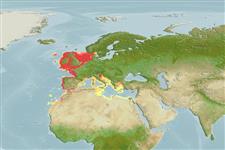Actinopterigi (pesci con pinne raggiate) >
Perciformes (Perch-likes) >
Trachinidae (Weeverfishes)
Etymology: Echiichthys: Greek, echieys, eos = a little viper + Greek, ichthys = fish (Ref. 45335).
Ambiente / Clima / Range
Ecologia
; marino demersale. Subtropical, preferred ?; 59°N - 20°N, 19°W - 36°E
Eastern Atlantic: North Sea to the Mediterranean, Morocco and Madeira. Reported from the Canary Islands (Ref. 3397).
Size / Peso / Age
Maturity: Lm ? range ? - ? cm
Max length : 15.0 cm SL maschio/sesso non determinato; (Ref. 4675); common length : 10.0 cm TL maschio/sesso non determinato; (Ref. 4645)
Body elongate. Coloration grey-brown on the back and silvery-white on the sides. No spines in front of the eyes (Ref. 35388).
Littoral and benthic, on sandy, muddy or gravelly bottoms, from a few meters to about 150 m (in winter). Rest on the bottom, often buried with eyes and tip of first dorsal fin exposed. Considered as the most dangerous of the European weevers, both for its poison and for its frequent occurrence very near to beaches (Ref. 4675). There are venom glands on the first dorsal fin, which is totally black, and on the gill cover (Ref. 6790). Also Ref. 57406.
Life cycle and mating behavior
Maturità | Riproduzione | Deposizione | Uova | Fecundity | Larve
Roux, C., 1990. Trachinidae. p. 893-895. In J.C. Quero, J.C. Hureau, C. Karrer, A. Post and L. Saldanha (eds.) Check-list of the fishes of the eastern tropical Atlantic (CLOFETA). JNICT, Lisbon; SEI, Paris; and UNESCO, Paris. Vol. 2. (Ref. 6790)
IUCN Red List Status (Ref. 115185)
CITES (Ref. 94142)
Not Evaluated
Human uses
Pesca: scarso interesse commerciale; Pesce da pesca sportiva: si
Informazioni ulteriori
BibliografiaAcquacolturaProfilo di acquacolturaVarietàGeneticaFrequenze allelicheEreditarietàMalattieElaborazioneMass conversion
Strumenti
Special reports
Download XML
Fonti Internet
Estimates of some properties based on models
Phylogenetic diversity index (Ref.
82805): PD
50 = 1.0020 [Uniqueness, from 0.5 = low to 2.0 = high].
Bayesian length-weight: a=0.00490 (0.00196 - 0.01224), b=3.11 (2.89 - 3.33), in cm Total Length, based on LWR estimates for this (Sub)family-body shape (Ref.
93245).
Trophic Level (Ref.
69278): 4.4 ±0.7 se; Based on diet studies.
Resilienza (Ref.
69278): .
Vulnerability (Ref.
59153): Low vulnerability (10 of 100) .
